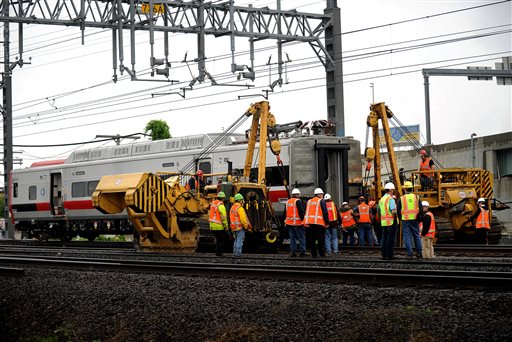BRIDGEPORT, Conn. — Connecticut commuters endured slow trips to work Monday following last week’s train collision that that injured 72 people and disrupted rail service into New York City.
It took Gary Maddin of Milford an hour to make what is normally a 20 minute drive from his home to the Bridgeport train station. From there, he planned to board a shuttle bus to Stamford where he could catch a train to Grand Central Station in New York.
“It’s a lot,” he said. “It’s a nightmare just to get into the city today.”
Metro-North was using 120 buses to help rail commuters make their way around the scene of Friday’s accident.
A shuttle train was operating about every 20 minutes Monday morning between New Haven and Bridgeport. From there commuters could take an express bus to Stamford or a local bus that also made stops in Fairfield and Westport.
Many decided to drive instead. State transportation officials said traffic on Interstate 95 and the Merritt Parkway was at a crawl Monday morning, with the trip between Bridgeport and Stamford estimated at about an hour during the height of the rush hour. The trip normally takes about 25 minutes.
“It was bad but not the nightmare that a lot of people thought it would be,” said Judd Everhart, a DOT spokesman. “Those two highways are pretty congested on a regular day.”
Officials say Friday’s collision impacts about 30,000 people who normally use the train.
David Cox, a 52-year-old human resources manager from Waterbury, said his bus ride from Bridgeport to Stamford took 1 ½ hours, making his entire trip about 3 ½ hours, an hour longer than normal.
“It’s something you have to live with and you just make due,” he said, after boarding the train for the final leg of his commute. “You can’t get upset over it.”
Lt. J. Paul Vance, a state police spokesman, said the department dispatched extra troopers and tow trucks to respond to car accidents.
“It’s definitely busier, heavier traffic,” he said. “We’re so far, so good.”
About 700 people were on board the trains Friday evening when one heading east from New York City’s Grand Central Terminal to New Haven derailed just outside Bridgeport. It was hit by a train heading west from New Haven. Nine remained hospitalized on Sunday, with one critical.
Metro-North officials expected it would be days before train service was restored as crews worked around the clock to rebuild 2,000 feet of track, overhead wires and signals. Inspections and tests also must be completed before service can return to normal, Metro-North President Howard Permut said. The damaged rail cars were removed from the tracks on Sunday, the first step toward making the repairs.
“Residents should plan for a week’s worth of disruptions,” Connecticut Gov. Dannel P. Malloy said Sunday at a news conference in Hartford.
State officials said not only would travel times will be significantly longer than normal and trains crowded, but parking at Stamford and other stations with train service was also expected to be a major problem. Commuters who can are advised to use the Harlem line in New York.
“If you are going to New York and you get to New York or you’re transporting yourself to New York you may decide that perhaps you should stay there for the duration of this disturbance,” Malloy said.
Amtrak service between New York and New Haven was also suspended and there was no estimate on service restoration. Limited service was available between New Haven and Boston.
Jim Cameron, chairman of the Connecticut Rail Commuter Council, said he’s asked officials in numerous towns to suspend parking rules to accommodate what could be tens of thousands of motorists driving to unaffected train stations. Twelve stations are affected by the shutdown.
Investigators are looking at a broken section of rail to see if it is connected to the derailment and collision. Officials said it wasn’t clear if the rail was broken in the crash or earlier.
NTSB investigators arrived Saturday and are expected to be on site for seven to 10 days. They will look at the brakes and performance of the trains, the condition of the tracks, crew performance and train signal information, among other things.
The MTA operates the Metro-North Railroad, the second-largest commuter railroad in the nation. The Metro-North main lines — the Hudson, Harlem, and New Haven — run northward from New York City’s Grand Central Terminal into suburban New York and Connecticut.
The last significant train collision involving Metro-North occurred in 1988 when a train engineer was killed in Mount Vernon, N.Y., when one train empty of passengers rear-ended another, railroad officials said.
Send questions/comments to the editors.



Success. Please wait for the page to reload. If the page does not reload within 5 seconds, please refresh the page.
Enter your email and password to access comments.
Hi, to comment on stories you must . This profile is in addition to your subscription and website login.
Already have a commenting profile? .
Invalid username/password.
Please check your email to confirm and complete your registration.
Only subscribers are eligible to post comments. Please subscribe or login first for digital access. Here’s why.
Use the form below to reset your password. When you've submitted your account email, we will send an email with a reset code.